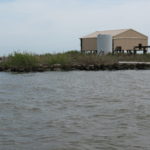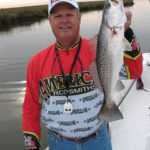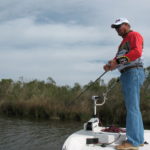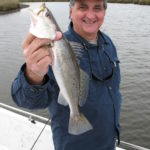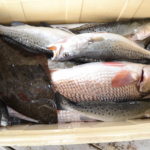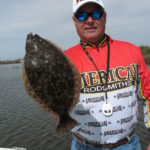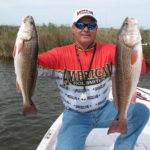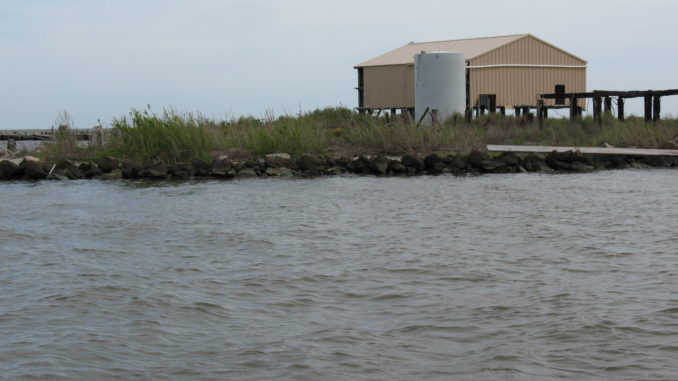
You don’t have to pay Carnival or Royal Caribbean to island hop in March. Just cruise on down to Dularge for some island hopping through trout-infested waters.
I wanted to time my trip to Dularge to see how long it would take and how many miles it was between my house in Kenner to Capt. Bill Lake’s camp on Bayou Dularge. It’s actually an easy drive down Highway 90 to the Houma/Highway 182 exit, and then follow 182 through Houma, past the Civic Auditorium, and as soon as you cross the high-rise bridge you take an immediate right to get to Highway 315, and turn left.
From there it’s about 20 miles to Jug’s Marina in Dularge, or in my case, I drove past Jug’s and went over the levee to Lake’s camp and boat sheds. Less than 70 miles by car, and about an hour-and-20-minutes drive time. Having to weave through downtown Houma from stoplight to stoplight on 182 is what slows the drive, but even so, it’s not a long delay.
And it’s definitely a trip worth taking in March, which is, by all accounts, a challenging month for anglers. We’ve long dubbed it a “transition” month, which means the trout are beginning to transition from their deep winter haunts in the inside waters toward their ultimate destination, the warm waters of the Gulf of Mexico. They are driven to migrate by the strongest of all primeval instincts: survival. And the trigger, according to Lake: water temperature.
“As long as the water temperatures stay in the 50s, the trout will stay in the inside where they have deep-water retreats,” he said. “If February is a cold month and it keeps the water temperatures low, they won’t begin moving until mid-March. But if it’s as mild a February as we had in January, the transition could begin early, and those trout might be on the islands already, staging, preparing for the last leg of their journey to the Gulf.”
Trout, like all creatures, are endowed by the Creator with instincts finely tuned to ensure their survival. For instance: When the current moves, whether tides are rising or falling, they know that the bait they feed on moves in that current and it’s like pushing a button, engaging their feeding mechanism. Fish will instinctively hunt and feed in a current. When the current stops, it’s like pushing a “pause” button, and they rest.
And being so incredibly tuned to their environment, they instinctively know when the current is falling sharply to retreat from the shallow water of the marsh into deeper water so as not to be caught aground. And they know the minute the current stops it’s safe to return to the shallow marsh because the water will soon rise.
They’re also acutely aware of subtle changes in water temperatures, and once those temperatures head toward 70 degrees, another button is pushed and they automatically begin their trek toward the warm, salty Fulf to feed, to spawn and to ensure the survival of their species.
“The water temperatures hit that magic 70-degree number in March,” Lake said. “Give or take a week or two, according to how cold it is in February, but nothing will hold back the change of the seasons, and this month those trout will show up in big numbers on the islands, and I’ll be there to greet them.”
The islands Lake is referring to are a set of small marsh islands about mid-way along the route from the deep inside waters of Dularge to the Gulf, located in Caillou Lake, Sister Lake and Moncleuse Bay. It’s about a 20-minute boat ride from the dock in Dularge to the islands, and Lake says this month they’ll be surrounded by trout.
“It’s an easy straight run down Bayou Dularge from the dock,” he said. “Just turn south at Grand Pass and head southeast to the three islands in a row. None of them have names, except we call the first one the Conservation Island because there was once a conservation facility on it. But all that remains on it today is wreckage.”
The legend of Grand Pass
“The old timers say that 50 or 60 years ago, Lake Mechant and Caillou Lake never touched each other,” said Lake. “They were completely separated from each other by a good-sized swath of marsh, which was itself divided by Bayou Dularge.
“To cross from one lake to the other meant beaching your boat and dragging it across the marsh into Bayou Dularge, crossing the bayou, and from there dragging it across the marsh to the other lake. But a couple of trappers decided to dig out a narrow ditch connecting the two bodies of water, making it just wide enough to paddle their canoe from one to the other. Today, that opening between the two waters is called Grand Pass, and it’s probably near a quarter mile wade and 50 feet deep! It’s a legend, but the old timers swear that it’s true.”
The problem
The islands won’t start holding fish until spring does its thing and starts warming the water. That’s when mullet and minnows show up at the islands in hordes and so do the trout that eat them. But we were fishing in the deep winter, perhaps as much as a month before the first sign of trout. So our plan was to pass by the first three islands out of Grand Pass just so I could see their layout and get a feel for what was soon to come. But we’d have to look for our fish in what Lake called North Dularge, an interior area of deeper canals and dead-ends.
The winds were stiff and the seas were kicking up as we made our way to the first island, the “Conservation Island,” as locals call it. The island is littered with the debris from the former camp, and there is still a lot of tattered structure on the island and in the water. Rocks, pilings and remnants of wharf surround much of what remains of the once large island, which was formerly connected to the second island before years of erosion took their toll. Lake says those rocks are usually the very first place the trout will show up.
“My theory is that the March sun will heat up those rocks, and that heat will radiate even under water, like putting a submersible heater in the water, and that’s why we often catch trout snuggled right up against the rocks in March,” he said.
Baits
“We like to use soft plastic baits in purple/chartreuse on a ¼-ounce jig, fished under a cork or tightlined out here,” said Lake. “Swim baits are also productive, such as the Tsunamis in the golden bunker, seatrout, blue back or glow/chartreuse colors.
“DOAs under a cork and shiny hineys will work well, and it’s also a good place to try topwater baits. The water is only about a foot or two deep around the islands and there’s an oyster bottom all around them, so if you’re tightlining you’ll likely lose some tackle.”
Island hopping
Besides the three islands just southeast of Grand Pass in Caillou Lake, there are numerous islands in Moncleuse Bay and Sister Lake, all of which are prime in March. Lake says you won’t have enough time in the day to work over all the islands, but all will hold trout.
“These islands are the main staging areas on the migration route as the trout move toward the Gulf,” he said. “Naturally, the islands were once much larger and more numerous than they are now, but the trout will swarm in and park out here all month long gorging on mullet and baitfish, and preparing for the next stage of their journey to the Gulf.
“We fish all of these islands, and we’ll hop from one to the other looking for trout. The trout will be here in March, whether early in the month or mid-month, depending on the weather, but at some time this month you’ll catch trout here, and plenty of them.
“The key to success this month is to patrol the islands and look for baitfish. If you find bait, you can bet the trout are there too. Concentrate at the points where you see bait or at least those with some good current moving around them. I usually troll or drift while we cast all around the area until we get a few hits, and then we stick the Power-Pole and see if we can put some numbers in the boat. If the action stops, resume your troll. This is stick-and-go fishing. Stick when they bite, and go when they don’t.”
Lake says each of the islands are worth trolling completely around, but the main places to focus your attention is on the points, and he says to thoroughly fish both sides of them.
“And don’t bother looking for birds to lead you to the fish this month, because it’s too early for the shrimp to show up. You’ll have to find the fish on your own,” Lake said.
Tides and winds
Lake always prefers to fish a falling tide any time of year, but a rising tide will produce fish also.
“The ideal situation would be to catch it at high tide and be able to fish as it falls,” he said. “I find that is the most ideal situation.
“If you get out here and the tide is low, you’ll have to pick up your big motor so you won’t drag it on the bottom when trolling. And the biggest threat this month, besides the cold, is the winds. This is all open water so any wind stronger than 10 mph can muddy up the water and make fishing unproductive. I prefer a south or southeast wind, blowing under 10 MPH. That wind will push good clean salty water into the area and lots of bait and trout.
West winds are the worst. If you get a slight west wind, it’s no problem, but any persistent west wind will dirty up the water and spoil the fishing. March is usually known as a windy month, so in order to beat the winds and catch some fish you’ll have to get out on the water either very early or very late, when the winds are the calmest of the day.
“We plan to be at the islands 10 to 20 minutes before daybreak. I want to be fishing at daybreak. That way, by the time the winds kick up, by 9 or 10 in the morning, I’m heading back to the dock with my fish. We often have our limits by 9 or 10.
“The other option is to fish just before dark, because the winds usually lay down and the fish will feed aggressively just as it turns dark.”
Redfish
“Reds show up in good sizes and numbers in the lakes this month as well,” Lake said. “The whole north side of Caillou Lake, from Grand Pass to Bayou Sauveur, is real productive, as are the ponds in the northwest side of Caillou by Grand Pass.
“Troll along the shorelines, casting gold spoons, spinnerbaits and soft plastics, and focus on points, cuts and coves. Any shallow coves that hold enough water to troll and float in should hold reds, and gold spoons will be the best bait. Reds will also hit topwater baits in the shallow water, and they’re a lot of fun to catch that way.
“Another good bet is to fish the ledges of Grand Pass itself for big bull reds and black drum. Use your depth sounder to find the drop offs. The water steeply deepens from the bank, and when you see it drop from 10 or 12 feet down to 30 feet or so, fish there. The bulls never really leave the pass all year round, and a bottom rig fished with cracked crab will put a definite bend in your rod. These fish will all likely be too big to keep. You’re allowed one per person over 27 inches, and you’ll be hard pressed to catch one under that size.”
Meanwhile, we meandered through a few canals and dead-ends and put together a nice mixed box of speckled trout, redfish and flounder, but all the while anticipating some serious island hopping in March.
Capt. Bill Lake can be reached at (985) 637-3712.
Destination Information
HOW TO GET THERE — From New Orleans, take I-10 west to I-310 south, exit at Highway 90 Houma. Follow Highway 90 to the Houma/Highway 182 exit, and then follow 182 through Houma, past the Civic Auditorium, and as soon as you cross the high-rise bridge you take an immediate right, go to the stop sign and turn left on Highway 315. From there it’s a bit under 20 miles to Jug’s Marina.
MARINAS — Jug’s Boat Launch has two back-downs, and offers fuel, ice, live minnows, crabs and dead shrimp.
MAPS — Standard No. 314 map of Cocodrie.
